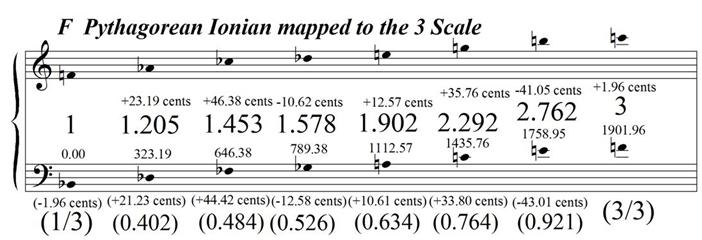
The F Pythagorean Ionian 1% wide Scale. 3-limit just intervals stretched outward to fill the 1212-cent "octave."
 Mobtown Modern's "State of the Union" @ Contemporary Museum, Baltimore, MD
Mobtown Modern's "State of the Union" @ Contemporary Museum, Baltimore, MD The Relache Ensemble accompanying the silent films of Maya Deren, Wallace McCutcheon, Edwin S. Porter and James Cruze @ The Gershman Y, Philadelphia, PA
The Relache Ensemble accompanying the silent films of Maya Deren, Wallace McCutcheon, Edwin S. Porter and James Cruze @ The Gershman Y, Philadelphia, PA both the dancing figures against a night sky in Night and the surrealist story telling found in Meshes. After the intermission, there was a reprise of The Very Eye of Night, with Kyle Gann's music performed instead of the Ito heard earlier. The difference of image and music juxtaposition was stark and startling. Where the spaciousness of Ito's music brought out the sense of the infinite of the star-filled sky Gann's pulsing rhythms found a natural visual ally in the ballet on screen.
both the dancing figures against a night sky in Night and the surrealist story telling found in Meshes. After the intermission, there was a reprise of The Very Eye of Night, with Kyle Gann's music performed instead of the Ito heard earlier. The difference of image and music juxtaposition was stark and startling. Where the spaciousness of Ito's music brought out the sense of the infinite of the star-filled sky Gann's pulsing rhythms found a natural visual ally in the ballet on screen. Happy Apple @ International House, Philadelphia, PA
Happy Apple @ International House, Philadelphia, PA
 Marty Ehrlich: The Long View. 2002. Enja Records: ENJ-9452 2.
Marty Ehrlich: The Long View. 2002. Enja Records: ENJ-9452 2. Dave Douglas Quintet: Live at the Bimhuis. 2002. Greenleaf: Paperback Series vol. 1.
Dave Douglas Quintet: Live at the Bimhuis. 2002. Greenleaf: Paperback Series vol. 1. Ursel Schlicht/Reuben Radding: Einstein's Dreams. 2005. Konnex Records: KCD 5165.
Ursel Schlicht/Reuben Radding: Einstein's Dreams. 2005. Konnex Records: KCD 5165.
 Ornette Coleman: Beauty is a Rare Thing [disc 2]. 1993. Atlantic/Rhino Records: R2 71410.
Ornette Coleman: Beauty is a Rare Thing [disc 2]. 1993. Atlantic/Rhino Records: R2 71410. Thomas Chapin Trio: Third Force. 1991. Re-released as disc 1 of Alive (box set). 1999. Knitting Factory Records: 35828 02482 2.
Thomas Chapin Trio: Third Force. 1991. Re-released as disc 1 of Alive (box set). 1999. Knitting Factory Records: 35828 02482 2. Fantastic Merlins: Look Around. 2007. Innova: 670.
Fantastic Merlins: Look Around. 2007. Innova: 670. Misha Mengelberg: The Root of the Problem. 1997. Hat Hut Records: hatOLOGY 504.
Misha Mengelberg: The Root of the Problem. 1997. Hat Hut Records: hatOLOGY 504. Ellery Eskelin: Premonition. 1993. Prime Source: cd 2010.
Ellery Eskelin: Premonition. 1993. Prime Source: cd 2010. Wayne Horvitz/Gravitas Quartet: Way Out East. 2006. Songlines: SGL SA1558-2.
Wayne Horvitz/Gravitas Quartet: Way Out East. 2006. Songlines: SGL SA1558-2. Misha Mengelberg Quartet
Misha Mengelberg Quartet As a live concert, the Misha Mengelberg Quartet put on a world class performance in Philadelphia. Four musicians with intense creativity and a responsiveness that makes each one of them an ideal collaborative partner. Brad Jones effortlessly picked up phrases and gestures tossed off by Dave Douglas and wove them into the sonic fabric on bass. And the wealth of ideas and sense of play developed between Mengelberg and Bennink was a pure joy to behold.
As a live concert, the Misha Mengelberg Quartet put on a world class performance in Philadelphia. Four musicians with intense creativity and a responsiveness that makes each one of them an ideal collaborative partner. Brad Jones effortlessly picked up phrases and gestures tossed off by Dave Douglas and wove them into the sonic fabric on bass. And the wealth of ideas and sense of play developed between Mengelberg and Bennink was a pure joy to behold.

 Elliott Sharp/Tectonics: Errata. 1999. Knitting Factory Records: KFR-255.
Elliott Sharp/Tectonics: Errata. 1999. Knitting Factory Records: KFR-255. Ornette Coleman: Dedication to Poets and Writers. 1962. Also released as Town Hall, 1962. Music Magic: 30010-CD.
Ornette Coleman: Dedication to Poets and Writers. 1962. Also released as Town Hall, 1962. Music Magic: 30010-CD. Marc Ducret: Un Certain Malaise. 1998. Screwgun Records: 70005.
Marc Ducret: Un Certain Malaise. 1998. Screwgun Records: 70005. Annie Gosfield: Burnt Ivory and Loose Wires. 1998. Tzadik: TZ 7040.
Annie Gosfield: Burnt Ivory and Loose Wires. 1998. Tzadik: TZ 7040. Mark Feldman: What Exit. 2006. ECM: 1928 B0007361-02.
Mark Feldman: What Exit. 2006. ECM: 1928 B0007361-02. Jonathan Zorn: for Rob Powers: Suite no. 2 - additive feedback. 2003. Set-Projects: Set - 03.
Jonathan Zorn: for Rob Powers: Suite no. 2 - additive feedback. 2003. Set-Projects: Set - 03. Mazen Kerbaj: Brt Vrt Zrt Krt. 2005. Al Maslakh: 01.
Mazen Kerbaj: Brt Vrt Zrt Krt. 2005. Al Maslakh: 01. Steve Reich: Music for 18 Musicians. Performed by the Grand Valley State University New Music Ensemble. 2007. Innova: 678.
Steve Reich: Music for 18 Musicians. Performed by the Grand Valley State University New Music Ensemble. 2007. Innova: 678. Miles Davis: The Complete On The Corner Sessions [disc 1]. 1972, 1973, 1974, 2007. Sony BMG Entertainment: 88697 06239 2-DI.
Miles Davis: The Complete On The Corner Sessions [disc 1]. 1972, 1973, 1974, 2007. Sony BMG Entertainment: 88697 06239 2-DI. Chris Mosley Trio: The Miraculous Aspect of Time. 2006. Red Button Records: RBR-101.
Chris Mosley Trio: The Miraculous Aspect of Time. 2006. Red Button Records: RBR-101. Myra Melford/Be Bread: The Image of Your Body. 2006. Cryptogramophone: CG 131.
Myra Melford/Be Bread: The Image of Your Body. 2006. Cryptogramophone: CG 131. Katt Hernandez/Evan Lipson: Hisswig. 2007. Limited run mini-disc.
Katt Hernandez/Evan Lipson: Hisswig. 2007. Limited run mini-disc. Elliott Sharp/Bootstrappers: GI=GO. 1992. Atonal Records: ACD 3014.
Elliott Sharp/Bootstrappers: GI=GO. 1992. Atonal Records: ACD 3014. Dave Douglas: Freak In. 2003. RCA/Bluebird: 09026-64008-2.
Dave Douglas: Freak In. 2003. RCA/Bluebird: 09026-64008-2. Matthias Kaul: Fever - Five Songs from a Percussionist. 2002. Nurnichtnur: LC 05245.
Matthias Kaul: Fever - Five Songs from a Percussionist. 2002. Nurnichtnur: LC 05245.